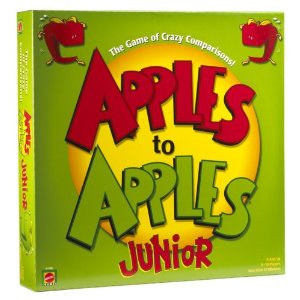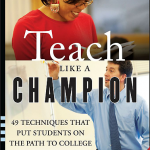Amazon.com EFL eikaiwa kids language courses Language learning vocabulary
by sendaiben
3 comments
Apples to Apples Junior (board game review for EFL teachers)
I received a copy of this game from a friend a few weeks back, and just got around to trying it with a class of junior high school students yesterday.
Basically the game consists of one player laying down an adjective card, like ‘scary’, and then the other players laying down nouns, like ‘car accident’, ‘octopus’, or ‘tree house’. The original player then chooses which of the nouns they feel is closest in meaning to the adjective or most appropriate. Players can also choose ridiculous or illogical cards if they want. The player that laid down the card that was chosen gets a point, and another player gets to decide the next adjective.
This game worked extremely well, as students had to understand all the words in order to play. There was a lot of asking and dictionary use, and students really seemed to enjoy the game. Being the junior version, the language used was appropriate for my keen junior high school students. I would estimate that they knew about half the words involved. We played for about fifteen minutes, but it would be just as easy to have shorter games once the students are used to the rules and start learning the language.
One thing I really like is that the adjective cards list two or three synonyms, and the noun cards have some simple facts or jokes printed on them, so there is a lot of potential for students to move beyond the basic vocabulary.
The game contains almost 600 word cards, so should be a useful resource for the long term. I thoroughly recommend this game, with the caveat being that it does not seem to be available in Japan, and amazon.com will only ship it to a US address. Still, if you can get hold of a copy, I think you’ll like it!
Amazon.com curriculum EFL eikaiwa ES expectations JHS kids reviews teaching The Book Depository theory university
by sendaiben
5 comments
Teach Like a Champion in Japan
Teach Like a Champion is a recent book by Doug Lemov. Despite the cheesy title, I found it interesting, inspiring, and useful, and heartily recommend it to any teacher facing classes (the techniques are probably less useful for teaching one on one).
The book was written from a US K-12 (kindergarten to twelfth grade) perspective, so is a perfect fit for teachers working in elementary or junior high schools. Not all of the techniques are suitable for high school or university students, but a lot of them are, particularly in Japan, so even teachers working at those levels should consider it.
Teach Like a Champion is based on a philosophy of efficiency (what works best for the most students in the least amount of time). It’s a mindset that I admire and have been trying to apply to my classes here for quite some time now. One of my favourite parts of the book is where Lemov talks about the opportunity cost of activities:
“(reading) is a high-quality activity (when done efficiently) that can be carried out in any classroom, at any time, and with limited additional preparation or expense required. You can always invest any stretch of time, short or long, in meaningful reading and reap a strong and predictable retun. Furthermore, if you know you could always be doing meaningful reading -in any class, at any time -you can examine your other investments of time critically: do they exceed the value of meaningful reading? Are they potentially higher return but riskier and therefore should be balanced with something more reliable? As you ask these questions, you may well find that reading crowds out some of the other ways you invest your time.”
This mindset permeates the book, and makes it very persuasive. The idea of the opportunity cost of classroom activities is a simple one that I had never really thought about specifically. On reflection, my benchmark activity teaching English in Japan is extensive reading. Now, for me to do something else in class requires that it be more profitable than ER. Using this idea makes a huge difference to lesson planning.
I really like how Lemov brings a critical eye to classroom practice, making the overall tone of the book one of experimentation. The bulk of the book, however, is taken up by 49 very specific teaching techniques. Lemov claims that after observing hundreds of masterful teachers, he found that many of them were using the same strategies and activities, which he describes in Teach Like a Champion. There is also an online supplement with videos of the teachers in question using the techniques. In my opinion it is worth buying the book just to get access to this resource.
Teach Like a Champion is not perfect. It can feel a little cultish at times (all the techniques have names, which Lemov explains as being necessary in order to clearly convey what he is talking about, but names like “at bat” or “pepper” sometimes feel a bit silly), and the focus is very much on the US K-12 system. However, most of the techniques are universal, and I have successfully implemented them with both small group eikaiwa kids and university classes. All things considered, Teach Like a Champion is one of the best books on teaching I have read (I’ve actually read it twice, and am about to re-read it again to refresh everything), and a couple of friends who have also read it feel the same way.
Unfortunately it doesn’t seem to be available through Amazon.co.jp, so I ended up buying the Kindle version from Amazon.com and reading it on my iPhone, but it’s worth getting a copy sent from the US. For a free postage and packing option, check out The Book Depository.
* Disclaimer: the links in this review are affiliate links. If you click on the links and then buy the product, Amazon or The Book Depository will pay me about 3% of the cover price. This comes out of their profits, it does not make the product more expensive for you than buying it normally. Think of it as a tip to this blog. Of course, if you prefer, you can go straight to their websites and search for the book yourself. I won’t hold it against you 😉

